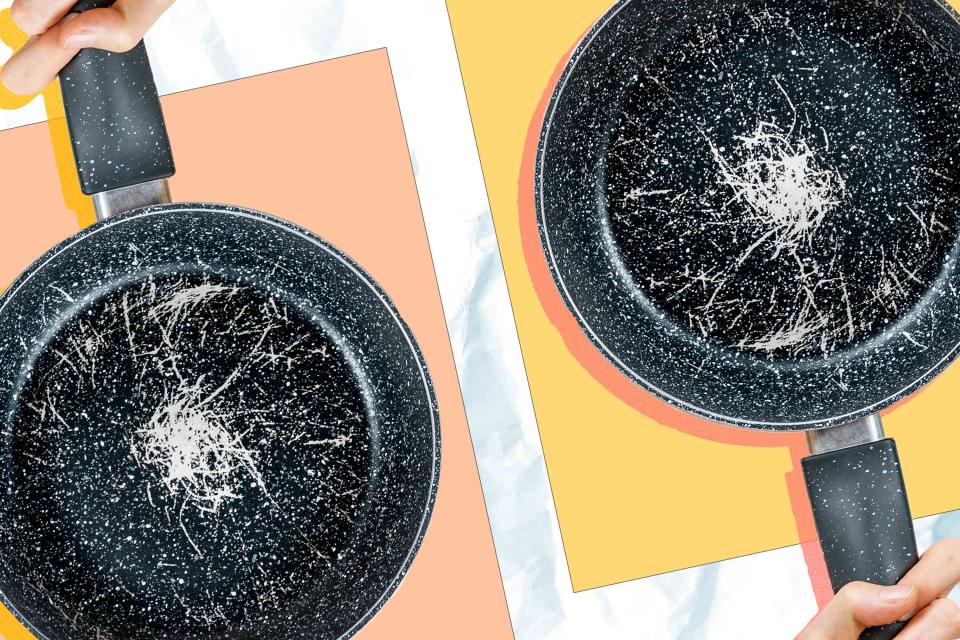Is It Safe To Use Scratched Nonstick Pans? Here’s What Experts Say
You can't get yourself to throw away your beloved nonstick pan even if it's scratched. Is that OK?

Simply Recipes / Wanda Abraham
There are few things in the kitchen that make cooking easier than a nonstick pan. Eggs cook seamlessly without sticking to the pan, grilled cheese browns so nicely, and pancakes are a snap. But unfortunately, amazing nonstick pans don’t stay perfect forever and sometimes get scratched. It’s not clear how safe this nonstick cookware is—particularly once it gets a scratch or chip.
Is it safe to keep using nonstick pans once they’ve been scratched? Here’s what the experts say.
What You Should Know About Nonstick Pans
The chemicals used to create the nonstick coating on pans are often PFAS (per- and polyfluoroalkyl substances), which are known as “forever chemicals” because they take so long to break down. One common PFAS is polytetrafluoroethylene (PTFE) which is found in the popular brand name Teflon. To add to the alphabet, some of the more commonly studied PFAS are perfluorooctanoic acid (PFOA) and perfluorooctane sulfonic acid (PFOS).
In 2006, the Environmental Protection Agency (EPA) began working with eight major companies to stop using PFOA by 2015 because of concerns about the chemical’s long-term impacts on human health and the environment.
You may see pans that claim to be free of PFOA or PFOS—two chemicals frequently used in the past—but that doesn’t mean they are guaranteed to be safe, says Katie Pelch, a scientist with the Natural Resources Defense Council (NRDC), the national environmental advocacy group. “If looking to purchase a new pan, also avoid PTFE or anything that includes ‘fluoro’ in the name, as these likely contain PFAS.”

2 Potential Risks of Cooking With Nonstick Pans
1. Overheating Nonstick Pans
“For a long time, it was believed that cooking with nonstick pans coated with ‘forever chemicals’ presented little risk to people; however, studies have shown for years that heating empty nonstick pans can release gasses and particles that are toxic to pet birds—literal ‘canaries in the kitchen,’” says Pelch. Scientists have found that these chemicals may be linked to various health issues including liver issues, high blood pressure, and some cancers in humans.
The Centers for Disease Control and Prevention (CDC) and EPA say exposure to PFAS at certain levels may be harmful to human health, but the effects of low levels of the chemicals are still unknown. Nonstick coating made without PFOAs presents no proven risks to humans, according to the American Cancer Society, other than the chance of flu-like symptoms when breathing in fumes from heated cookware. That’s why nonstick pans sometimes say they shouldn’t be heated past 500°F.
2. Scratched Nonstick Pans
When a nonstick pan made with PFAS is scratched or chipped, small particles can flake off into the food you are making. A 2022 study found that scratched pans coated with these chemicals release thousands to millions of microplastics and nanoplastics.
You should avoid using any scratched or dented nonstick pan to avoid exposure to potentially toxic chemicals. “It can be very difficult for consumers to understand which pans have ‘forever chemical’ coatings,” says Pelch.
It is safest to replace any nonstick cookware when the coating is damaged, particularly if it was made before 2015, says Whitney Linsenmeyer, PhD, RD, LD, an assistant professor of nutrition and dietetics at Saint Louis University, and spokesperson for the Academy of Nutrition and Dietetics. “If your food starts to stick to the pan, this is also a sign that the surface is wearing down, and it is time for a replacement.”

How To Protect Your Nonstick Pans
To protect nonstick cookware and to extend its life, Linsenmeyer suggests:
Hand wash with a soft sponge. There’s a greater chance of scratching the pan in a dishwasher.
Use rubber or wooden cooking utensils and avoid anything metal.
When storing, lay a cloth towel over the surface to prevent scratches from stacked pans.
Other Safer Cooking Options
Other safer nonstick surfaces don’t use the same toxic chemicals, like nonstick ceramic-coated pans that don’t have PFAS chemicals. Pelch suggests cast iron, stainless steel, and carbon steel. “I cook eggs most mornings in a cast iron skillet. And, as long as I pre-heat it properly, I have very few issues with eggs sticking. Even my 10-year-old is capable of cooking eggs in our cast iron!”
Read More:How to Clean and Season Cast Iron Cookware
You have to approach cooking differently than you do with nonstick pans. “Nonstick pans have a chemical coating that seals the pores of the metal of the pan so that the food cannot bind. That’s why you can put eggs in a nonstick pan before it’s hot and it won’t stick,” Pelch explains.
With cast iron or steel, the key is to preheat the pan thoroughly. “Preheating the pan makes the molecules of steel or iron heat up and essentially seals the surface so that food can't stick,” says Pelch. “If the pan isn't heated enough, the molecules are sluggish and atomic-sized pores allow food molecules to bind.”
Linsenmeyer, however, keeps nonstick pans in her kitchen and uses them regularly. “But I don't expect them to last forever in the way that my cast iron pans will last if treated well,” she says. “When my nonstick pans get scratched, I replace them with a new set. They are a staple in my cookware that I can't live without!”

